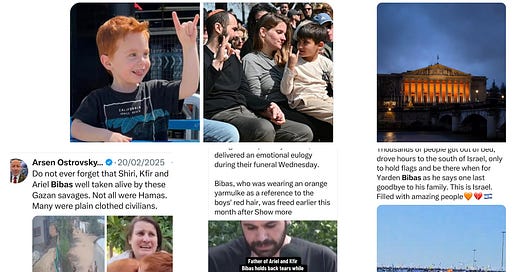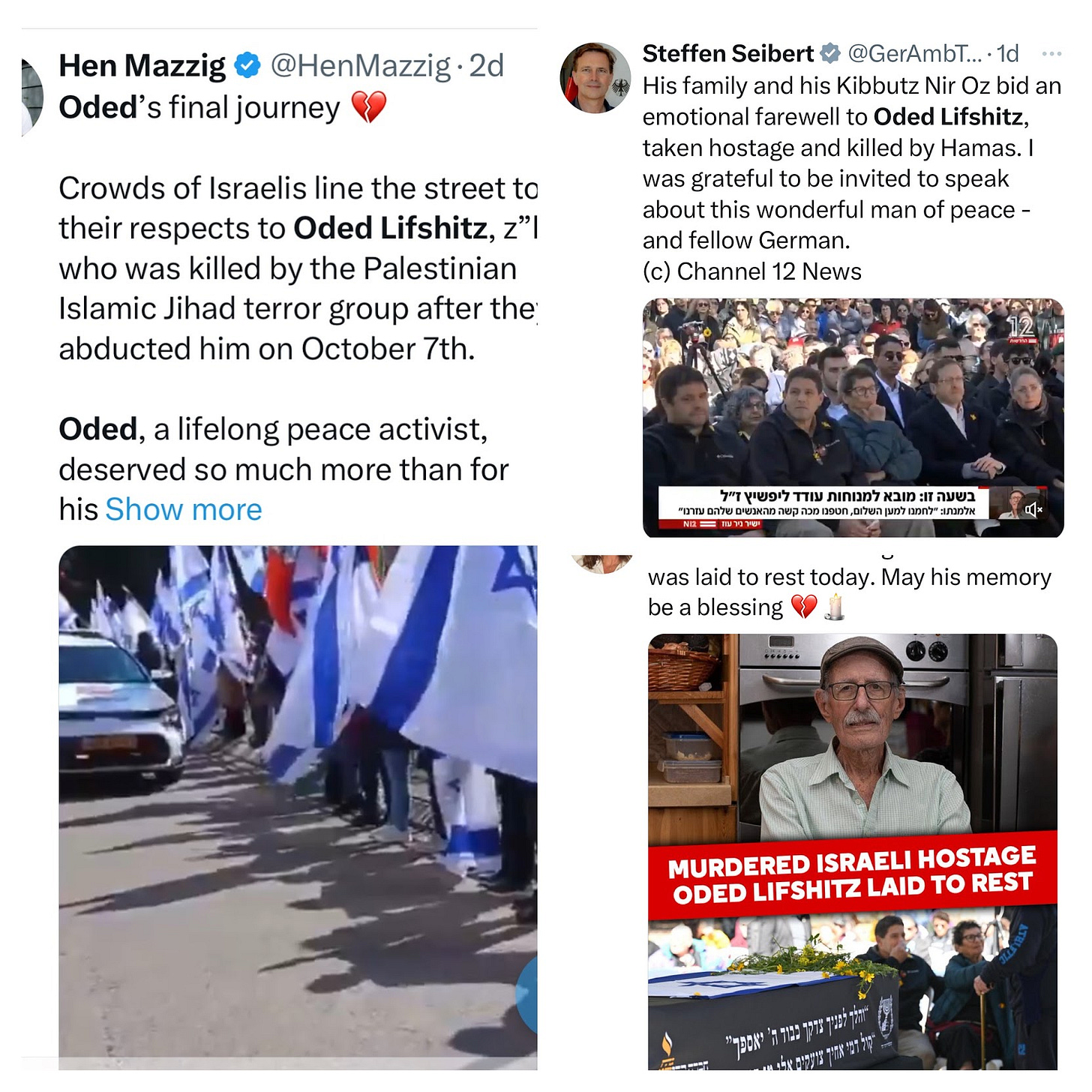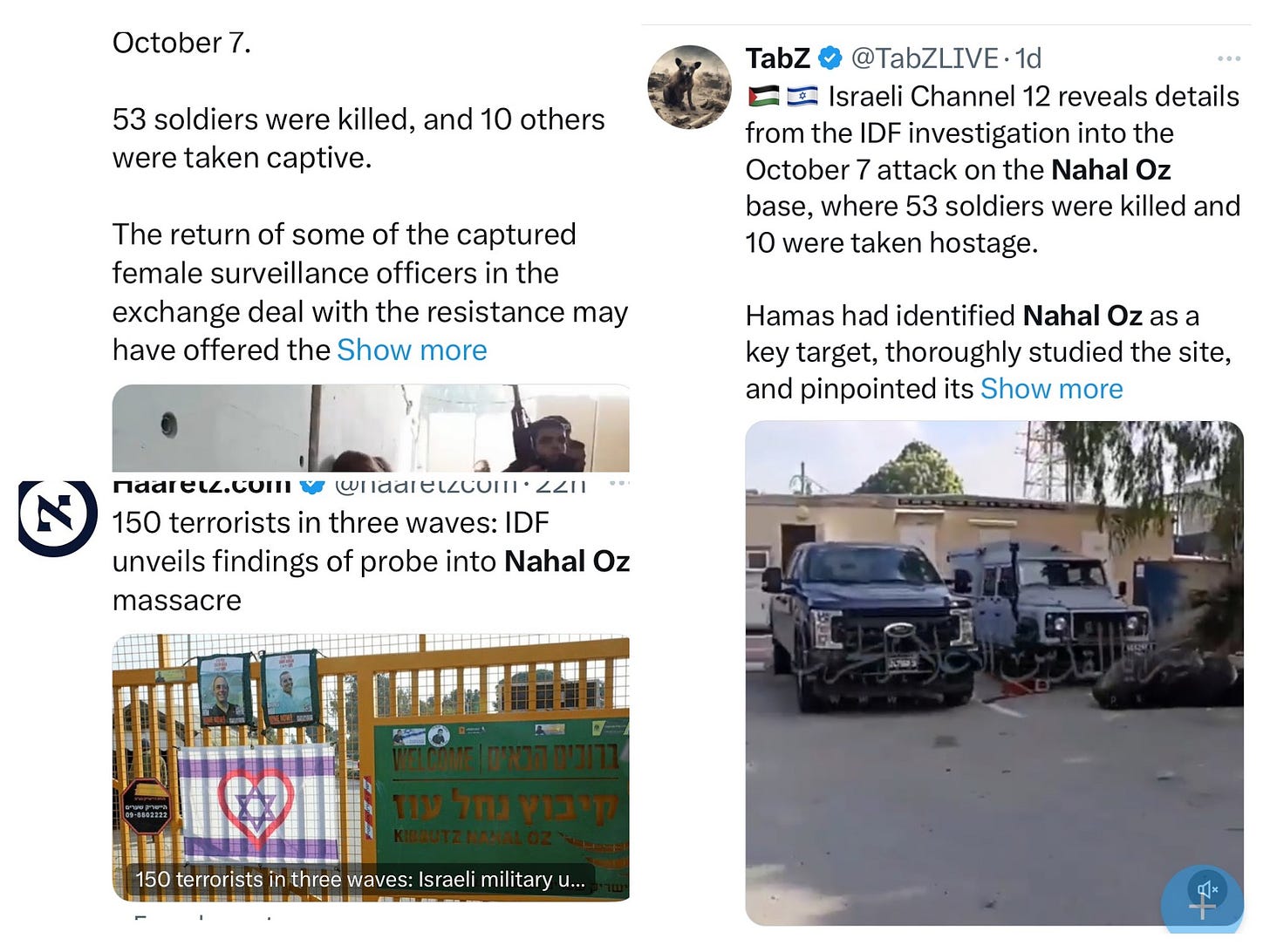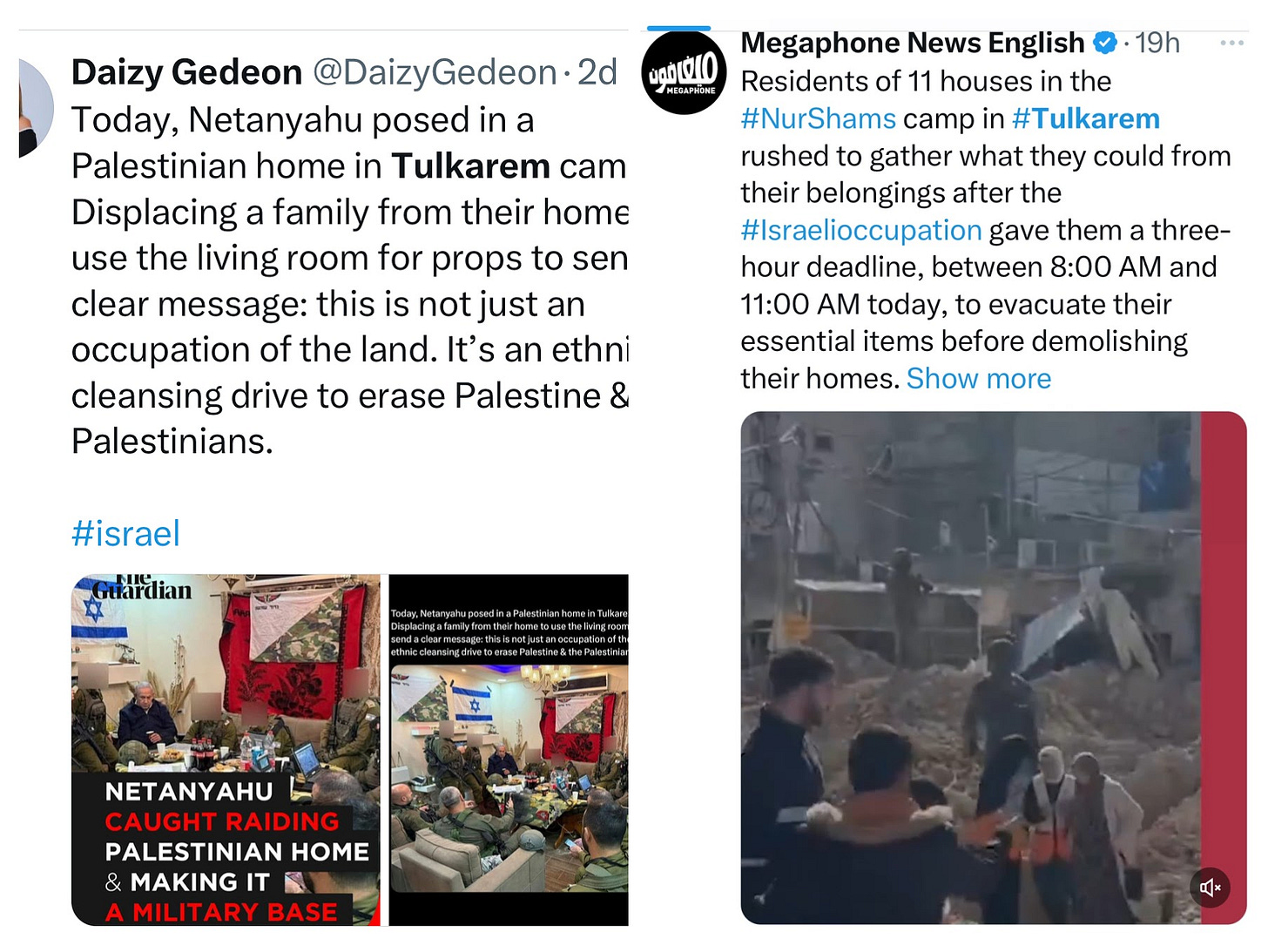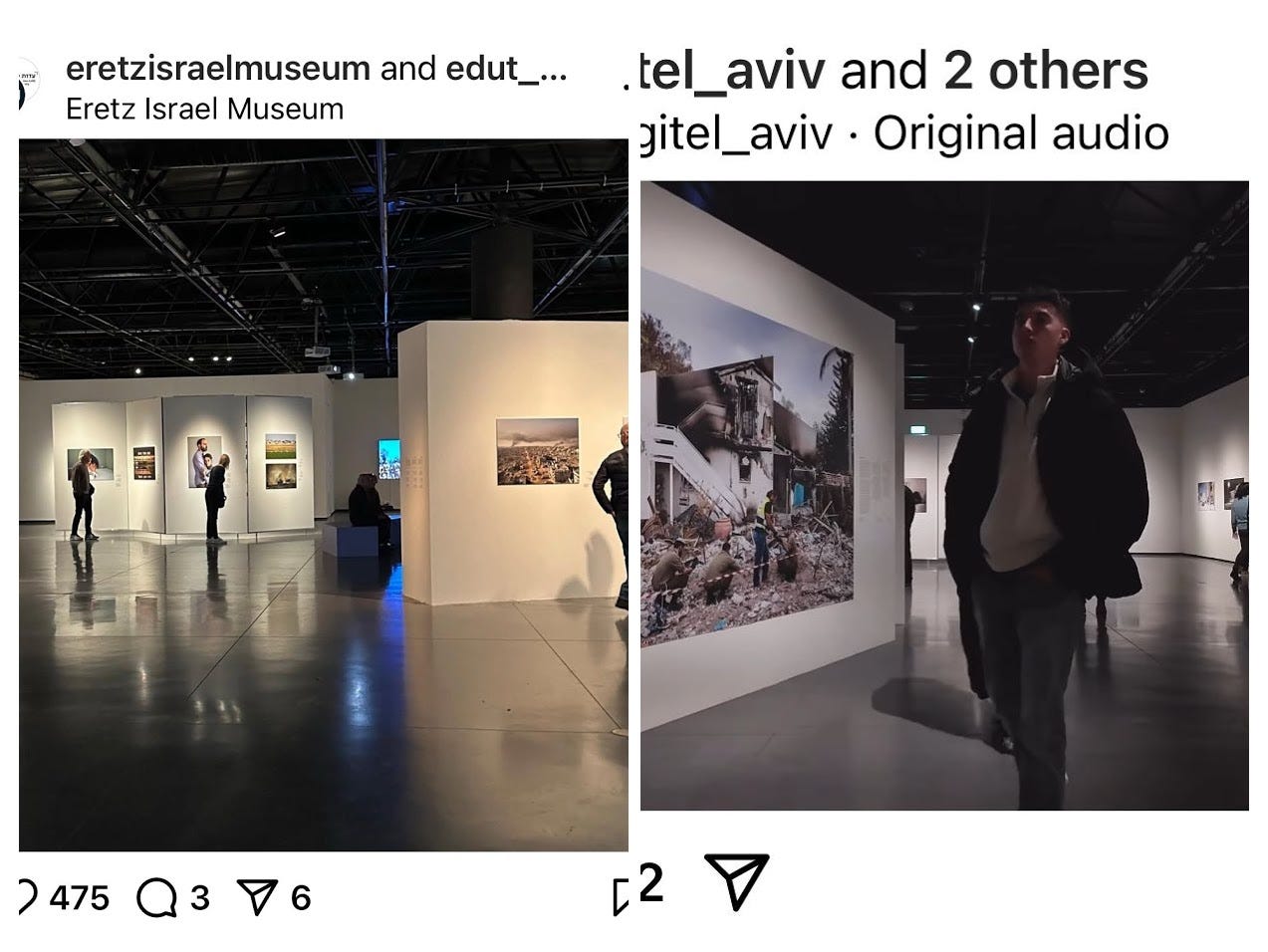Israel at War - Day 510
Gaza Ceasefire - Day 40
1. Shiri, Ariel and Kfir Bibas Brought to Rest
Shiri (33), Kfir (2) and Ariel (5) Bibas - kidnapped from their home in kibbutz Nir-Oz on October 7th, 2023, and murdered by their captors – were brought to rest together in a single casket earlier this week at a cemetery in the Gaza envelope. In a show of support for the family, thousands of Israelis lined the route and accompanied the funeral procession from central Israel to the south, as well as at roads and junctions in the north, holding orange-colored balloons and ribbons, in memory of red-headed Ariel and Kfir. The funeral ceremony was also broadcast live at Tel Aviv's Hostage Square, to show their support for the family, Diplomats from the U.S., U.K. Germany, France, Spain, Argentina and Italy were also present in the Square. Public buildings in Israel and in cities around the world, such as New York, Paris, Berlin and Budapest were lit orange in memory of Ariel and Kfir.
At the family’s request, the burial ceremony was held in the presence of family and friends only. Yarden Bibas, Shiri's husband and father of Kfir and Ariel – who was also kidnapped on October 7th and was recently released – eulogized his wife and two children, and spoke of their last moments before they were taken hostage: "do you remember our last decision together? In the safe room, I asked if we should 'fight or surrender.' You said fight, so I fought. Shiri, I'm sorry I couldn't protect you all”.
Ofri Bibas Levy, Yarden's sister, in her eulogy, spoke of the difficulty in accepting the fact that her sister-in-law and two nephews were gone, and criticized the government who failed to save their lives when it could, choosing revenge over saving the lives of her family and the other hostages: “our disaster as a people, and ours as a family, should not have happened, and it must not, must not happen again. They could have saved you and preferred revenge."
Earlier in the week, Ofri Bibas-Levy, said that the media, PM Netanyahu and Israeli public diplomacy channels were revealing details of the murders of her sister-in-law with no family authorization, adding that "this is outright abuse of a family that has already been enduring hell for 16 months."
2. Oded Lifshitz Laid to Rest, Hamas Release Four Bodies of Hostages
Hundreds of people attended the funeral of Oded Lifshitz at Kibbutz Nir Oz earlier this week, after his body was released by Hamas last week. Lifshitz was one of the founders of the kibbutz and was kidnapped from his home on October 7 along with his wife Yocheved by Islamic Jihad. According to the forensic team who identified and examined his body, Lifshitz was killed in captivity more than a year ago. The funeral was attended by President Isaac Herzog, who asked Oded for "forgiveness that the State of Israel did not protect you, your family and your kibbutz." Also attending the funeral were the ambassadors of Germany, Britain and Poland, and Einav Zangauker, whose son Matan Oded is still held hostage in Gaza.
In her eulogy, his wife, Yocheved, thanked him for their 67 years together, and added: "our kidnapping and your death shake me. We fought all these years for social justice and for peace, and unfortunately, we suffered a severe blow from the people we helped on the other side."
Late Wednesday night this week, Hamas returned the bodies of four hostages, in return for the release of 600 Palestinian prisoners and detainees. The four are Shlomo Mantzur, Ohad Yahalomi, Tsachi Idan, and Itzhak Elgarat who were identified by the forensic teams upon the arrival of their bodies in Israel.
Shlomo Mantzur, 86, was the oldest hostage. He was taken from his home in Kibbutz Kissufim, near the Gaza border. His sister, Hadassah, told reporters that "we've reached an absurd situation where we take comfort in receiving a body to bury."
Itzik Elgarat’s brother, Danny, one of the vocal leaders of the hostages’ families, called - in a personal statement published in an Israeli media outlet - for a public awakening, for real civil resistance, and not just symbolic protests
3. Israeli Defense Force Investigations of October 7th Were Published and Presented to the Communities, With Apologies to the People
Days before the chief of staff, Herzi Halevi steps down, the IDF presented a series of reports that investigated the chain of events that enabled Hamas militants to occupy the Kibbutzim on the border with Gaza.
The bottom line is that the IDF failed to identify Hamas preparations, and to understand that it was an operative plan, and not a long-term vision drafted by Hamas. IDF and all intelligence agencies were deeply convinced that Hamas had no interest in violent escalation, and that the organization prefered a diplomatic agreement with Israel that will enable them to keep getting the stream of resources and money from Qatar. No senior IDF officers dared to challenge the strong conviction that Hamas planned to carry out the invasion.
The magnitude of the massacre executed by Hamas was possible because of a series of events, and the bottom line is that the army was absent at the border when needed. Between 6:30am and 8:30am three waves of Palestinian militants were able not only to enter the Kibbutzim, but to murder, kidnap, burn, loot and wantonly destroy everything - with nobody to fight back, except the people themselves with hardly any weapons and resources.
The IDF investigation tried to be candid and open. The army admitted to not being there for the civilians, they admitted to adhering to a false concept where they deeply believed that Israel had managed to deter Hamas, that Hamas had no intentions and no interest in initiating a violent confrontation with Israel, that the kibbutzim were safe since all the needed measures were taken by the army, that the army believed it had all the intelligence resources needed to identify any intentions from Hamas, that the fence on the border was strong and protective enough, that there are advanced high-tech devices and abilities to protect the border, that Israel is strong and has significant tactical advantages, that the army could identify any hostile moves in Gaza, could track all the communication between Hamas leaders, and that they are closely tracked.
The IDF presentations were held in separate meetings for each community where attendees were asked to leave their smart phones out of the room so as not to record. The IDF delegation to the communities included two generals. The meetings were critical to the communities in helping them understand the IDF response on October 7.
Bottom line: one core question was not answered - where was the army? Many of the communities were neglected and not protected. For some it took hours until the soldiers came. The neglect enabled the massacre of more than 1,200 people and the abduction of a further 251, some of whom are still in captivity. The army was very accurate in listing the chain of events, minute by minute, but failed to explain why this happened. What was the failure that made all concerned officers fixate on the same paradigm without challenging it?
Another disturbing question is when will the political level take responsibility? Until now, almost a year and a half from October 7th, none of the decision makers have taken any responsibility for the events of October 7, 2023. PM Netanyahu refuses to do so, and strongly opposes any attempt to establish a state commission of inquiry to dive into the chain of events and decisions that enabled the October 7th events. He wants to establish a politically oriented committee, that will place all the blame and responsibility on the army and intelligence agencies, while absolving the political level of any responsibility.
The communities were left disappointed with an extensive void where all their questions were not answered.
4. Israeli Defense Force (IDF) Continues to Operate in the West Bank, Causing Death and Destruction:
40,000 Palestinians were displaced from their homes in one of the refugee camps in the West Bank. The Israeli army deployed tanks in the northern part of the West Bank for the first time in 20 years. The IDF is conducting an extensive operation against what it defines as terror in a variety of refugee camps.
Under a significant push and pressure from the right-wing partners of the government, to fight terror, accompanied by the rhetoric, and under the fog of war in Gaza and the hostages deal, the IDF is carrying out a long, massive and deadly operations in different locations. Analysts indicate that the IDF is using Gaza tactics in the West Bank, meaning no more accurate and focused operations, that attempt to avoid large scale of destruction, but rather using tanks and raids to destroy what the army defines as terror infrastructure capabilities. The areas in focus now are Jenin and Tulkarm in the northern West Bank.
Earlier this week it was reported that tens of thousands of Palestinians had to leave their homes in order to enable the army to operate in their neighborhoods. Houses were destroyed on a large scale and many Palestinians were killed. Unfortunately the Israeli mass media barely reports on these operations and the resulting high human toll. The public was mainly preccupied last week with the hostages deal and the funerals of the Israelis who were murdered during their captivity.
The West Bank has been a very active and bloody front for some weeks now, with the IDF engaged in active warfare on a large scale.
5. The Annual Photojournalism Exhibition Closed With a Record Number of Visitors
Tens of thousands of people visiter the annual exhibition of photojournalism and documentary photography that was held in Eretz Israel Museum in Tel Aviv. This is the 21st year of the exhibition that is the outcome of a collaboration among journalists and photographers. The exhibition- Local Testimony - depicted the story of October 7th, including the large scale massacre at the Kibbutzim and small towns on the border with Gaza, and also the destruction of those communities, the intensive demonstrations calling on the government to bring all the hostages back home, photos of the hostages that returned after 50 days in captivity, mainly women and children, photos from the battles in Gaza and other key events in Israel from 2024. The main inspirational event at the exhibition was the Paris Olympic Games 2024, and the Paralympics, in which Israeli athletes achieved impressive results and managed to win a record number of medals. Among the participants were many photojournalists who work for foreign press and international news agencies including Associated Press, Reuters, Agence France-Presse and more. It is important to say in this context that there is no free access to Gaza for journalists. The only way to report from Gaza, which is under the rule of the Israeli army, is by getting access granted by the IDF spokesperson, who decides who will be granted access, for how long, and by being embedded to an army unit. This is how the IDF is trying to control the narrative.
9,000 images were sent to the competition, and only about 150 made it to the final and were printed and humg on the walls. Local Testimony is one of the most popular exhibitions in Israel, especially the most popular photo exhibition.

